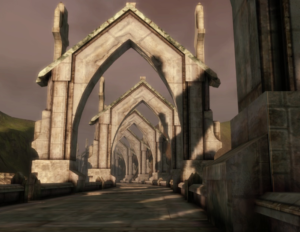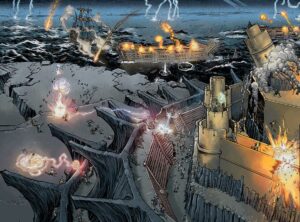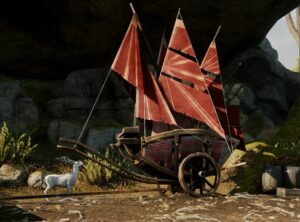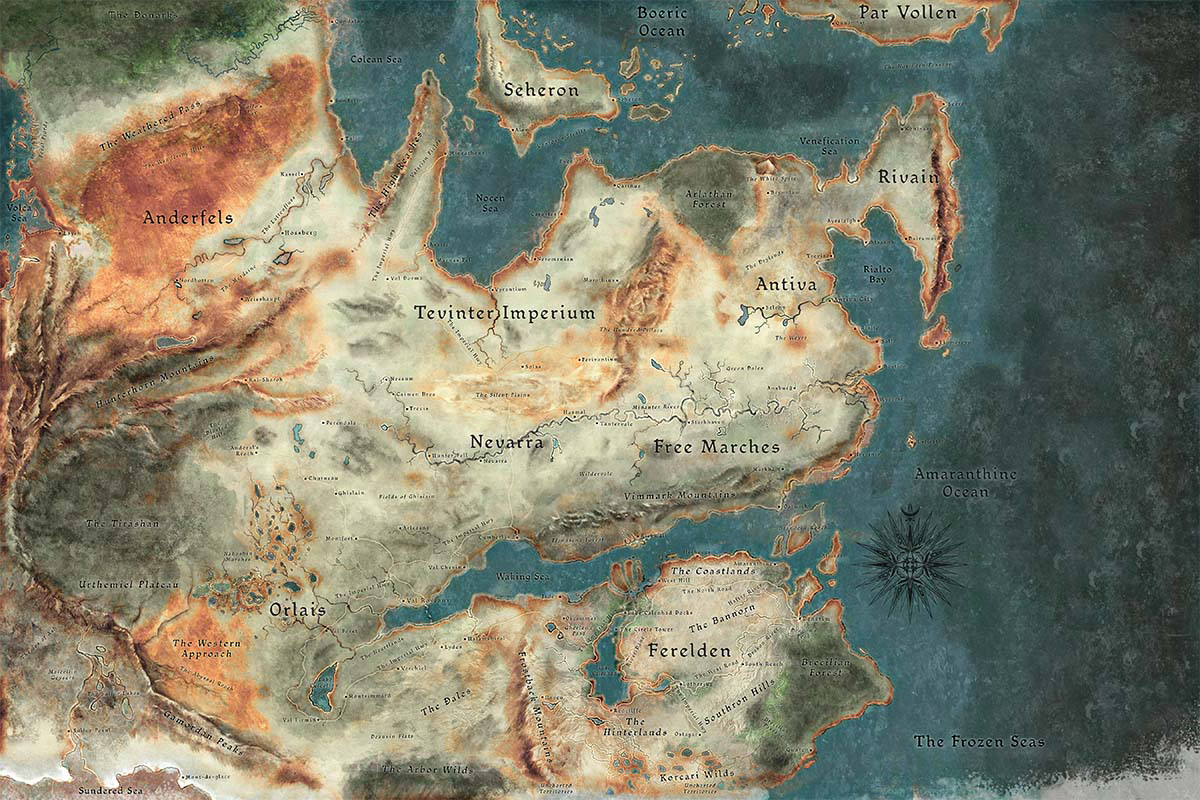Tomorrow marks a decade since one of the defining moments of my life. On my eighteenth birthday, way back in 2011, I was three months away from ending high school, five months from matriculating at Gettysburg. On that day, however, one thing eclipsed all others: I received and first played the game Dragon Age: Origins.
As with any nerd, I still remember when I was introduced to all my great fictional obsessions, and Dragon Age is no exception. For my money one of the greatest fantasy constructs since Tolkien’s Middle Earth, the Dragon Age franchise now covers three full games, three mobile games, and dozens of novels and graphic novels. Its world of Thedas is a dark one, filled with mystery and corruption both political and supernatural, but it is also filled with majesty and heroism to match.
So why am I talking about Dragon Age on a history blog? Well, like many other fantasy worlds (including Tolkien’s original, as we’ve written about here on Concerning History), Dragon Age draws inspiration from numerous historical sources to build its world. Thedas is filled with myriad nations and peoples, and whether through intentional homages to history or tropes that have historical origins, its creators have delivered a world which a discerning historian can delight in. Indulge me, then, as I serve as your guide to the world of Dragon Age and, just maybe, convince you to try journeying there yourself.
The Tevinter Imperium: Rome, but with Mages
Any discussion of the world of Dragon Age must begin with the country whose legacy can be felt in nearly every corner of Thedas, from the origin of its main villains (the darkspawn) to the ruins that dot its landscape. A vast mage-ruled empire of conquest that at its height controlled the entire continent of Thedas, Tevinter is the second-oldest polity in Dragon Age. By the time of the main stories, however, Tevinter is a shadow of its former glory. First splintered by the invasion of barbarian tribes, then fractured by a new enemy bearing a strange new religion, Tevinter is now locked in a seemingly eternal war with their enemy, the Qunari. It is hard to imagine a closer analogue to Rome, master of Europe until inundated in the West by Germanic peoples and, two hundred years later, truncated in the East by the ascendant forces of Islam, consigned to centuries of conflict defending its remaining dominions. Even Tevinter’s far-reaching influence echoes Rome’s long shadow in the history of Europe.

The Qunari: Ottomans with Horns
One can’t talk about Tevinter without talking about their mortal enemy at the time of the Dragon Age games: the Qunari. These ox-men, as they are often derogatively called, hail from somewhere beyond the northern shores of Thedas, and their initial onslaught was so fierce that only a series of three Exalted Marches (the Dragon Age equivalent the Crusades) could halt and drive them back. The Qunari’s success can largely be traced to two phenomena. First, their massive dreadnoughts employ weapons of a destructive power previously unknown by Thedas, fueled by an explosive powder known as gaatlok. Second, the Qunari are generally immune to the infighting seen in the rest of Thedas thanks to their unique religion, which emphasizes each individual’s role in serving the collective good. Both of these factors clearly showcase a connection between the Qunari and the historical bane of the Byzantine Empire: the forces of Islam, first faced as Arabs in the seventh century and later as Seljuks and Ottoman Turks. Islam, adopted as the Arabian national religion immediately prior to their invasion, was instrumental in laying the Eastern Roman Empire low. Additionally, it was the Ottomans’ use of cannons that finally delivered the Byzantine capital of Constantinople to their hands. While Tevinter hasn’t similarly fallen to the Qunari yet, some say it’s only a matter of time.

The Elves: History’s Downtrodden
Dragon Age prides itself on its more realistic approach to politics and culture in a fantasy setting, and nowhere is this more evident than in its treatment of elves. Rather than a beautiful superrace, the elves of Thedas are scattered and oppressed by humanity. Before humans came to Thedas, the elves ruled the entire continent in a massive empire more akin to that original fantasy stereotype, but that empire crumbled under unknown circumstances. Now, elves either live as slaves or poverty-stricken servants in special Alienage quarters of human cities or they wander the world as the nomadic Dalish in massive aravels—wind-sailing wagons. Historians can find many inspirations rolled into one for Dragon Age’s elves. The Dalish evoke Roma, while the Alienages are reminiscent of Jewish ghettos. The idea of a previous empire whose people now form the bulk of slaves even has parallels in the Roman preference for Greek slaves after conquering Macedonian Greece.

Orlais: An Idealized France
The most powerful contemporary nation in Thedas is Orlais, an obscenely wealthy empire ruled by a caste of endlessly politicking elites. Orlesians rarely show their true faces in public, instead wearing masks reflective of their station or projected personality. Orlesian chevaliers are considered some of the best warriors in the world. It’s fairly easy to see the historical parallels to late medieval France, with chivalric knights, elaborate court ritual, and absolute royal authority. Orlesian characters even speak with French accents!

Ferelden: Familiar Britain
Players’ first introduction to the world of Dragon Age comes through the country of Ferelden, considered by many Thedosians to be one of the more backward kingdoms (a common comment is that it “smells like wet dog”). It is a rougher kingdom along the southern frontier, recently independent after throwing off the yoke of Orlesian imperialism and fiercely proud of its barbarian heritage. This introduction is a good one, as many will feel right at home in this Britain-inspired region. From its founding by barbarian tribes (one, the Avvar, literally one v away from sharing the name of one of Charlemagne’s historical nemeses) to its Norman-esque conquest (here reversed, unlike in medieval England), Ferelden feels right at home to modern fantasy sensibilities.

Rivain: North African Pirates
In the north of Thedas can be found Rivain, a poor nation heavily influenced by the Qunari. Once a part of Tevinter, Rivain was first conquered by the Qunari, then liberated in a war that left its countryside devastated. It is now the favorite haunt of pirates, and no one is ever quite sure where its loyalties lie. In this way, its position is similar to that of medieval and early modern North Africa, devastated by Roman wars in the sixth century and home to the famous Barbary corsairs.
Antiva: A Mediterranean Milieu
Just south of Rivain is Antiva, one of the liveliest—and deadliest—countries in Thedas. Briefly taken by the Qunari but soon lost, Antiva is known for its rich culture and trade goods, among them fine leatherwork and wine. It does not field a standing army because it doesn’t have to; its infamous assassins, the Antivan Crows, are so feared that no kingdom will invade and risk their vengeance. Who can ask for a better parallel to Sicily and southern Italy, briefly taken by Muslims in the Middle Ages and known for the world’s most famous criminal organization, the Mafia?
The Free Marches: Italian Autonomy
Between ascendant Orlais and shrinking Tevinter lie the Free Marches, independent city-states that only seem to unite when faced with a dire common threat. Northern Italy here gets its due, especially in the case of Kirkwall, which had once been the center of the slave trade just like medieval Venice (if medieval Venice had embraced its role and built huge statues of bound figures being tortured all over the place).

Nevarra: Monolithic Mausoleums
The kingdom of Nevarra is by and large a fantastical creation, filled with traditions of dragon hunting and necromancy. That last, however, does show one big influence. The Nevarrans worship their dead, often burying them in elaborate mausolea that take decades to build and make the Grand Necropolis a shadow city right outside the living capital of Nevarra City. These grand tombs are certainly spiritual siblings with the famous tombs of Pharaonic Egypt, and some concept art has even made the connection more tangible.

